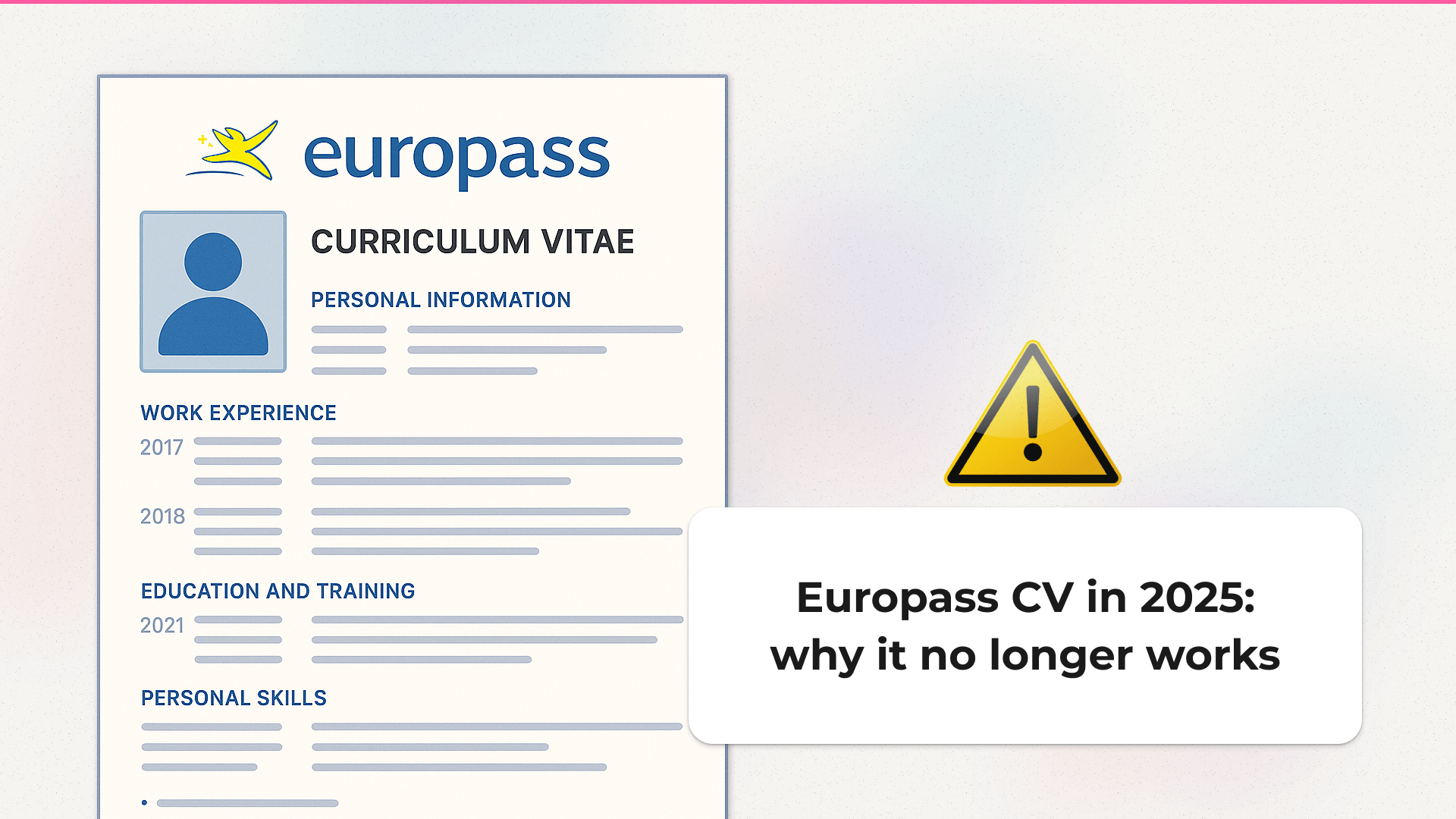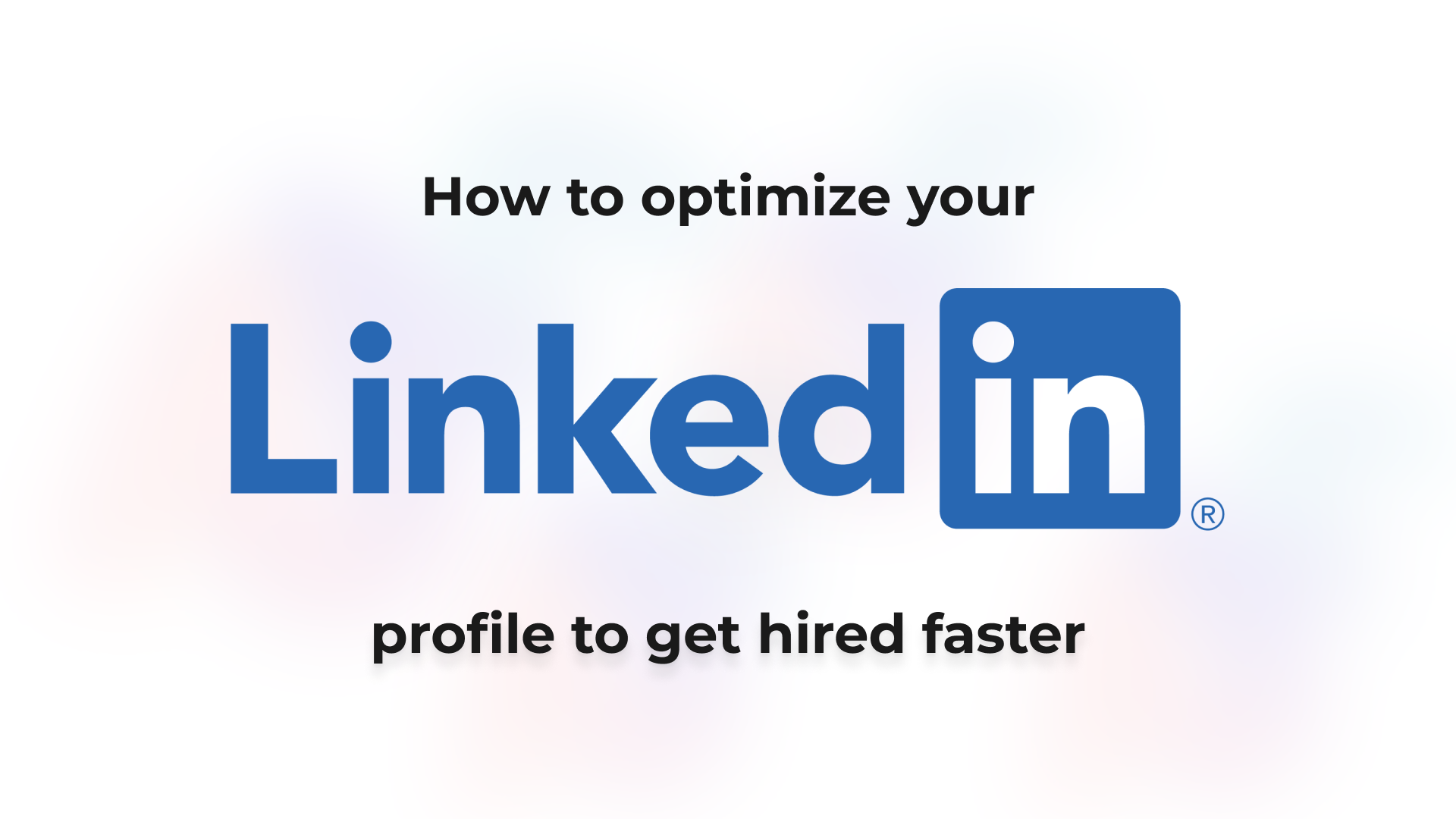
How to optimize your LinkedIn profile in 2025 and find a job faster
LinkedIn is no longer just a social network for keeping in touch with former colleagues. It's a talent search engine, a direct channel to recruiters and companies. And if you're job hunting, it's one of your best tools if you know how to use it well.
More than 90% of recruiters regularly use it to find talent, and 87% consider it essential for profiles to be updated and well-presented. An optimized profile improves your visibility, positions you as an expert in your field, strengthens your professional network, and multiplies your career opportunities (even when you're not actively looking). But all this happens only if you can clearly explain who you are professionally, what you excel at, and what value you can bring.
In this guide, you'll learn:
- How to optimize your LinkedIn profile to appear in recruiter searches.
- How recruiters use LinkedIn.
- How to achieve a good SSI (Social Selling Index) to boost your visibility.
- Common mistakes that make your profile go unnoticed.
- Why your resume and LinkedIn profile are complementary but not identical tools.
All with one clear goal: to help you find a job faster and with more options.
1. How to optimize your LinkedIn profile and boost your visibility
An optimized LinkedIn profile starts with a clear understanding of how you want to be perceived professionally.
It should be effective in two ways:
- For recruiters to find you for what they know they need.
- For them to understand, once they find you, why you and not someone else.
And that only happens if you understand that every section of your profile (from your photo to your headline) is part of a single message. A message that should clearly state what you do well, in what context you provide the most value, and what kind of opportunities you're seeking.
1.1 Profile photo and banner image
According to LinkedIn, profiles with a photo receive up to 21 times more views and 9 times more connection requests.
Use a clear, professional, and recent photo. You don't need a professional studio, but good lighting and a neutral background are essential. If you can subtly look to the right, even better: on mobile devices, people will see your photo right next to the connect or follow button. And avoid group cut-outs, selfies, or overly casual photos.
The same applies to your banner image (also known as a cover photo). This is often an ignored space, but it can significantly reinforce your message. Use it to enhance your profile: an image related to your industry, a defining quote, your key skills, or even your personal website. Tools like Canva or Figma Community offer free templates for LinkedIn banners.
1.2 How to write a professional LinkedIn headline
Your headline is the most visible part of your profile: it appears when you comment, apply for jobs, or when someone searches for a profile like yours. That's why it's the most crucial element to refine.
By default, LinkedIn uses your most recent job title, but you can edit it. Make it descriptive and clear. Think about how someone who needs your skills would search for you.
Instead of:
"Innovation Consultant"
It's better to use something like:
"Innovation Consultant | Digital Product Design | Strategy & Workshop Facilitation"
Or:
“Leading Marketing Teams Driving Traffic to Results | Performance & Growth in B2B Environments”
Include your specialties, key tools, or relevant keywords.
You have 220 characters, but the first 60 are the most important as they are visible on mobile. So, start with the essentials.
The key is for your headline not just to describe you, but to position you. It's not just what you do; it's how you do it and for whom.
1.3 How to effectively write the "About" section
Don't simply repeat your resume. Here, you have the opportunity to tell your story: who you are, how you work, and what your professional interests are. It's your most personal space and allows for more depth and detail than your resume.
Write in the first person. Use short sentences. If possible, tell it as a brief story, naturally incorporating relevant industry keywords.
Ideally, this story will answer these questions:
- What kind of professional are you?
- What do you do exceptionally well?
- Why do you do it?
- What kind of challenges are you interested in taking on, and where do you want to go?
While LinkedIn allows up to 2,600 characters, most users don't read even half of that. Aim for 400 to 800 characters (about 60-100 words).
1.4 How to write your work experience on LinkedIn
This section, too, shouldn't be a literal copy of your resume. It's an opportunity to provide details and context that you might not include on your CV to keep it concise. However, ensure it aligns with your resume for consistency, as recruiters will look for it.
Write three or four well-focused sentences that start with an action verb and conclude with a concrete result. If you can add supporting materials, even better. LinkedIn allows you to upload images, presentations, links, or even videos within the experience section.
Another often overlooked detail: if your official job title doesn't accurately reflect what you did or doesn't include keywords recruiters search for, adjust the title without being misleading. The priority is for your profile to be findable and understandable, not to replicate internal company jargon.
If you need inspiration for writing your work experience, here are examples and ideas to highlight your achievements.
1.5 Skills & Endorsements: the silent engine of your visibility
Skills are one of the most critical parts of your profile because they don't just indicate what you can do; they activate the algorithm that determines whether your profile appears in recruiter searches.
LinkedIn allows you to add up to 50 skills. Does that mean you need to fill them all? No. But you should ensure you include those that truly define your profile and align with the roles you're interested in.
Among those 50, three are especially visible because they appear first. Choose wisely which ones to display. And don't forget to combine them: hard skills and soft skills contribute differently but are equally important.
Another relevant aspect: on LinkedIn, you can ask other members to endorse your skills. Ask people you've worked with to confirm that you indeed possess that skill. This social proof, however simple it may seem, adds significant credibility to your profile.
And if you want to go a step further, you can take LinkedIn's Skill Assessments. These are short tests where, if you score above 70%, you'll receive a "Skill Verified" badge on your profile, giving you a significant advantage in recruiter searches.
Here's a list of the 7 most in-demand skills by companies in 2025, and here's a report on the competencies and sectors with the most opportunities this year.
1.6 Education, Certifications and Volunteer Work
Avoid listing courses just to accumulate them. Only add those directly related to your current specialty or the type of role you aspire to. Remember that your profile is a positioning tool, not a diploma repository.
Relevant certifications (whether technical, methodological, or tool-based) can help you stand out. Especially if they are recent, recognized in your industry, or include validations like those from LinkedIn Learning or Coursera.
And don't underestimate volunteer work and your personal projects. Sharing that you led a charity project, collaborated with an NGO on event organization, or worked with other professionals in a different context speaks volumes about initiative, commitment, and teamwork skills. It provides a human dimension that sometimes isn't visible in formal experience.
1.7 Recommendations
Recommendations on LinkedIn are an excellent way to add "social proof" to your profile and increase its credibility.
Not all recommendations are equally impactful. The most powerful ones come from people you've worked with directly: managers, colleagues, clients, or project collaborators. Ideally, they shouldn't just say, "Jane Doe is very professional and responsible," but rather a testimonial that details what you did, how you worked, and what results you generated.
You don't need 10 recommendations. With three well-written ones, your profile already conveys far more credibility than most.
If you want to receive, start by giving. Offering a sincere and specific recommendation is a great way to break the ice.
1.8 Personalize your URL
This is one of those changes you only make once, and it makes a huge difference. LinkedIn allows you to edit your profile's URL so it's not a random string of characters, but something clean and easy to share. For example: linkedin.com/in/anna-smith-product-manager
It not only looks more professional when you include it on your resume, email signature, or website. It also helps you rank better on Google. Your LinkedIn profile can appear in the top results if someone searches for your name, role, or specialty. But for that, the link must also be well-written.
Avoid including years, random numbers, or words that don't add value. If your name is taken, try combinations with your specialty or industry. LinkedIn allows you to change it up to five times in six months, but doing it right once is enough.
2. How recruiters use LinkedIn and how to appear in their searches
Recruiters don't search on LinkedIn like an average user. They use a tool called LinkedIn Recruiter that allows them to filter candidates by location, industry, years of experience, languages, skills, or previous companies. They can also search by keywords in the headline or "About" section.
This means your profile must be optimized for searches. Think of LinkedIn like Google. If you don't include the right words, you won't show up.
These are the parts that carry the most weight in the search algorithm:
- The headline.
- The experience section.
- Skills.
And these also hold relevance:
- The "About" section (summary).
- The number of connections.
- Recent activity (commenting, posting, or recommending content).
Perform a LinkedIn search for people with your same profile or the type of profile you aspire to. See how they describe themselves. What keywords do they use? What patterns repeat? Then, search for published job openings that interest you and roles you aspire to, and do the same exercise. Adapt your profile with those keywords, always staying authentic.
3. Your secret LinkedIn score: what the SSI is and how to use it to your advantage
LinkedIn has a metric that very few people know about, but it has a huge impact on profile visibility: the SSI, or Social Selling Index.
The SSI is an indicator that scores your profile from 1 to 100 based on these factors:
- Whether you have a complete and well-optimized profile.
- Whether you provide content and participate in the network.
- Whether you connect with relevant people in your industry.
- Whether LinkedIn considers you influential.
A high SSI means your account is active and optimized, making it more visible in searches and bringing more opportunities your way without you actively pursuing them.
You can check yours here: linkedin.com/sales/ssi
Here's a table showing how to improve each of the pillars that make up the SSI:
| Pillar | What it Measures | How to Improve It |
| 1. Establish your Professional Brand | How complete, consistent, and updated your profile is. | Improve your headline, refine your "About" section, add skills and achievements. |
| 2. Find the Right People | If you connect with relevant profiles. | Follow professionals and companies in your industry. Connect with relevant recruiters. |
| 3. Engage with Insights | Participation in the network. | Comment on posts, share useful content, respond thoughtfully. |
| 4. Build Relationships | Quality of your interactions. | Write personalized messages, follow up, express gratitude. |
You don't need to become an "influencer" to have a high SSI. Simply using LinkedIn as an active professional network with intention, consistency, and generating real interaction is enough. It's not about volume; it's about relevance.
4. Advanced LinkedIn features (almost) no one uses well
Optimizing your profile isn't just about writing it well. It's also about knowing how to strategically configure it so it works for you, even when you're not actively searching.
These features aren't always front and center, but they can make a big difference:
4.1 "Open to Work" Mode: controlled visibility
LinkedIn allows you to indicate that you're open to new opportunities. But there are two ways to do it:
- Private: only visible to recruiters using LinkedIn Recruiter, excluding those at your current company. This is the safest option if you don't want your current employer to know.
- Public: activates the green "Open to Work" frame on your photo. This increases your overall visibility but also makes it visible to your entire network.
Both options work. Choose based on your context. If your job search is discreet, activate only the private option. Recruiters will see it, and your profile will also appear higher in their searches.
👉 To activate it: go to your profile, click on "Show recruiters you're open to work," and select "Only recruiters."
4.2 Upload your resume to LinkedIn
LinkedIn allows you to have different versions of your resume ready to use when applying for a role. This is especially useful if you apply to different types of positions. This way, you can ensure you always send the most suitable resume without having to edit it every time.
👉 Settings & Privacy > Data privacy > Job seeking preferences > Application settings > Upload resumes.
A small action that saves time, errors, and misunderstandings. And it shows that, if you're job hunting, you know how to pay attention to every detail.
5. Networking strategies on LinkedIn
Networking on LinkedIn isn't about sending many invitations or collecting contacts like trading cards. It's about building real, useful, and lasting relationships. And that, like everything worthwhile, requires intention and effort.
5.1 Proactive and valuable networking
Building a useful professional network is a matter of proactivity, personalization, and giving before asking. Start by identifying professionals it makes sense to connect with: recruiters, people working at companies that interest you, industry leaders, colleagues you've collaborated with on projects. And always send a personalized invitation.
Additionally, participating in relevant groups, commenting thoughtfully on others' posts, and attending virtual events are small actions that significantly increase your visibility and credibility. If a recruiter sees that you not only have a good profile but also participate intelligently in industry topics, they'll pay closer attention to your profile.
And if you already have first-degree connections working at companies you're interested in, ask them for an introduction.
In general, it usually works better to give before asking. Share a useful resource, congratulate someone on an achievement, contribute a valuable opinion on a post. Networking isn't transactional; it's a long-term investment.
| Situation | Invitation Message |
|---|---|
| General Contact | "Hi [Name], I'm very interested in the work you do in [company/industry]. I'm developing my career in this direction and would love to connect." |
| Based on Content or Event | "Hi [Name], I saw your participation in [event] and loved your perspective on [topic]. I'd love to continue learning from your experience." |
| Through Mutual Connection | "Hi [Name], we share a connection in [Contact's Name], who spoke highly of your work in [area]. I'd love to connect." |
| To Recruiter, General Search | "Hi [Name], I've seen your experience in recruiting profiles in [industry], and I'm currently exploring new opportunities in that field. I'd love to connect with you." |
| To Recruiter, Specific Job | "Hi [Name], I saw you're looking for a profile for [position at company]. I'm very aligned with the requirements and would be happy to introduce myself as a candidate." |
5.2 How to message someone without paying for LinkedIn Premium
There's a little-known trick: if you see a "Message" button instead of a "Connect" button when you visit someone's profile, you can message them for free, even if they're not in your network. It's a specific feature, but if it's available, take advantage of it.
However, don't send a novel or a generic message. Be clear, polite, and direct. State why you're writing, what role you're applying for, or what your interest in connecting is. If you can, send a link to your online resume (you can create one on CandyCV).
And if you can't message on LinkedIn without paying for Premium, there's a Plan B: extensions like Hunter.io allow you to find professional emails associated with a domain. This way, you can write a well-crafted, personalized email and step outside the sometimes saturated LinkedIn channel for some recruiters.
6. What's the difference between your LinkedIn profile and your resume?
They're often confused because they share the same foundation (your experience, skills, professional history…), but your resume and your LinkedIn profile serve different functions. They are not interchangeable. And if you treat them as if they were, you're losing a large part of their potential.
They are two distinct tools that work in parallel and complement each other. Understanding these differences is key to maximizing the impact of each.
6.1 The Resume: direct, focused, designed to land an interview
Your resume is a document that responds (or should respond) to a specific job opening. It's an initial screening tool, designed to pass filters (human or ATS) and generate enough interest to get you called for an interview.
It shouldn't be generic or tell everything. It should be focused, tailored to the position and company, and clearly state why you're a good fit within seconds.
- Summarizes the essentials: experience, education, skills, achievements.
- Written for a reader with limited time (seconds, most of the time).
- Every line should answer a key question: "why should we interview you?"
A good resume doesn't just say what you've done. It tells who you are as a professional through what you choose to highlight, how you structure the information, the tone you use, and the story you decide to tell. But all of that has to fit on one or two pages. It's synthesis for impact.
Consult this guide for creating an effective resume in 2025. And if you don't have enough experience yet, here are several ideas for creating a resume with no work experience.
6.2 LinkedIn: your extended and connected version
LinkedIn isn't limited by space or a specific objective. It's a public, dynamic profile that functions as an active professional brand, positions you in your industry, and opens doors even when you're not actively looking.
- Doesn't need to adapt to every job opening: it's your general professional showcase.
- Can include much more: recommendations, multimedia, skill endorsements, side projects, interests.
- It doesn't just present you: it connects you. It allows you to interact, learn, share content, and build a reputation within your network.
Both should tell the same professional story, but they do so with different levels of detail and purpose.
Why you need both your resume and LinkedIn
Because they work as a team. The resume generates interest in a specific hiring process. LinkedIn reinforces, expands upon, and validates what the resume promises. If someone receives your resume and is interested, they will most likely go to LinkedIn to discover more about you: how you talk about your work, what others recommend about you, what content you share, how you engage in your industry.
And conversely, many opportunities arise without you having sent anything, simply because your LinkedIn profile was well-crafted. Then, you can start the process and send your resume.
| Aspect | Resume | LinkedIn Profile |
|---|---|---|
| Strategic Function | "Direct sales" tool. Responds to a specific need (a job opening). | "Continuous marketing" tool. Generates opportunities even without active searching. |
| Main Purpose | Convince to secure an interview. Convey focus, clarity, achievements. Adapt to job posting language. | Showcase your evolution, interests, values. Build authority. Position yourself without actively seeking jobs. |
| Audience | Specific individuals: recruiters and hiring managers reviewing your application. | Anyone who lands on your profile: recruiters, colleagues, clients, people with similar interests. |
| Narrative | Specific, tailored to what that company needs to read. Filtered, direct, and designed for quick scanning. | Open, more space for storytelling. Can delve deeper, include context, achievements, multimedia content, etc. |
| Type of Validation | Self-declared. You write what you did and achieved. | Others can also endorse your skills, leave recommendations, comment on your work. |
Conclusion
LinkedIn is an environment with its own rules, algorithms, invisible filters, and people on the other side making decisions in seconds. Optimizing your profile isn't an aesthetic choice or a mere formality. It's a real opportunity to position yourself, stand out intentionally, and generate opportunities without actively pursuing them.
But it's not enough to just fill in fields or follow checklists. What makes the difference is the approach: understanding what a recruiter is looking for, how the algorithm works, what a narrative conveys, and how to translate your career into a clear value proposition. This requires reflection, strategy, and tools that support you, not overwhelm you.
At CandyCV, we believe that job searching shouldn't feel like navigating blind. That's why we created a platform that combines technology and quality content to help you tell your story well, build a credible professional brand, and present yourself strategically. From modern templates to guides like this one, we're here to help you cut through the noise.
Your career deserves a profile with intention. And if we can help you build it, we're here.
👉 Try CandyCV for free and start truly standing out.
We're two product builders who care about quality, taste and doing things right. We want you to get that job you want, plain and simple. That's why we are building CandyCV to help you create a great resume and land a job for free. If you give us a try (and feedback!), we'll be forever grateful 😊
Alba Hornero
Co-founder and Product Builder
As CandyCV’s co-founder and a former product lead in HR tech, I’ve built ATS tools, optimized hiring processes, and interviewed hundreds of recruiters. I personally write every post with the intention to provide real, high-impact job search advice that truly helps you land your next role.

How to list Education and Certifications on your resume (with examples)
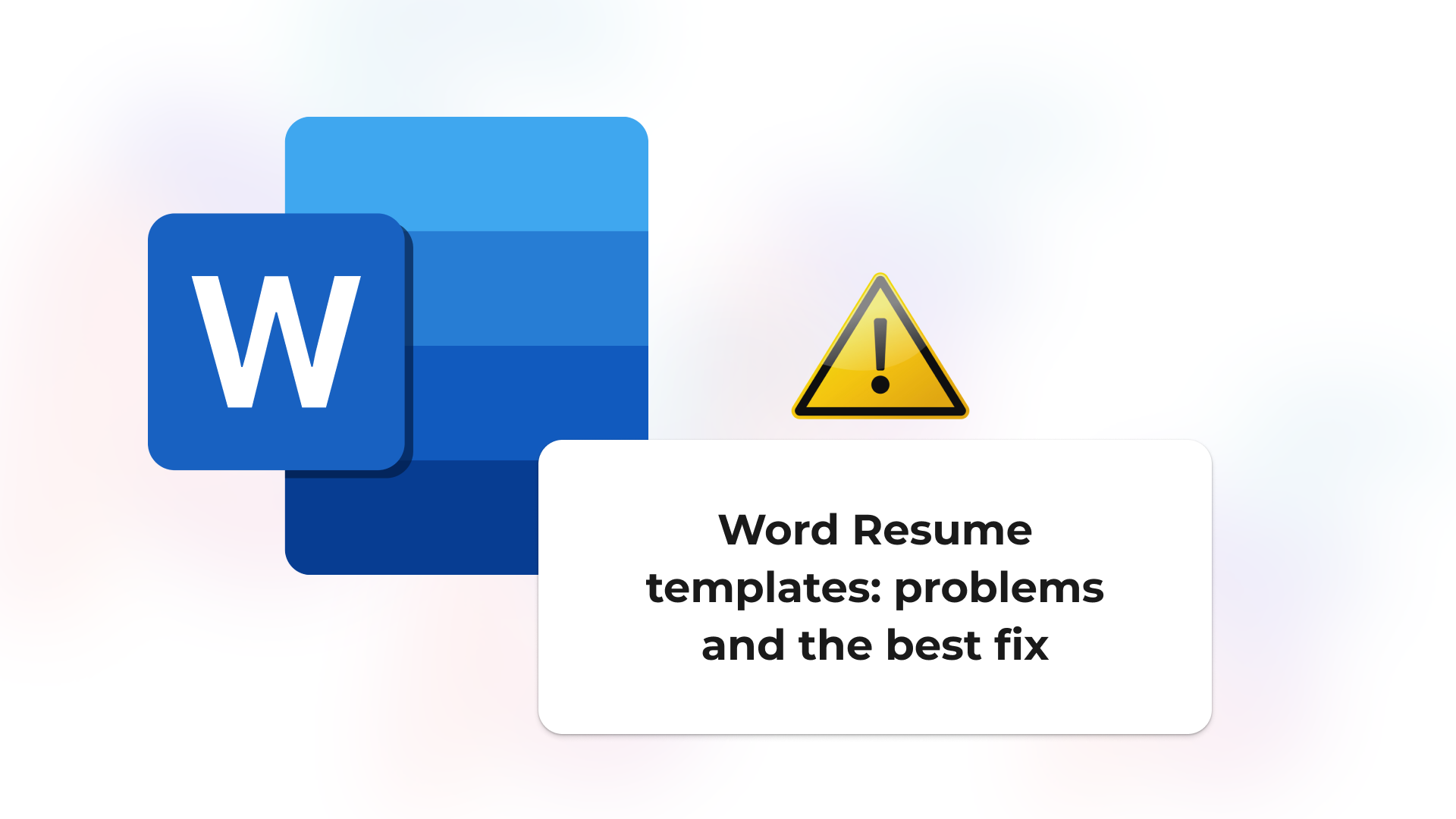
Free Word resume templates: why you shouldn't use them (and the best alternative)
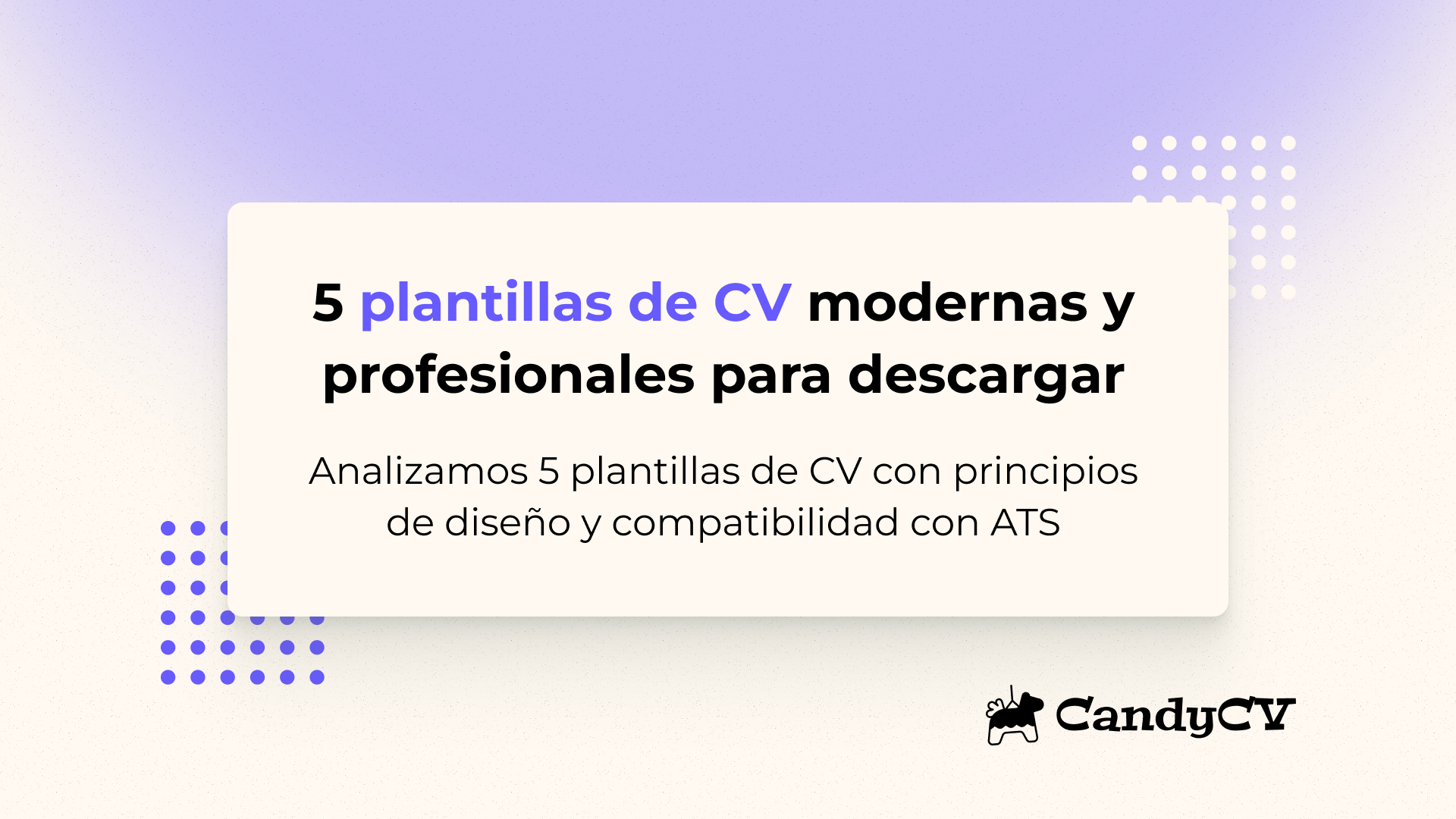
Download 5 free modern and ATS-friendly resume templates (design analysis)
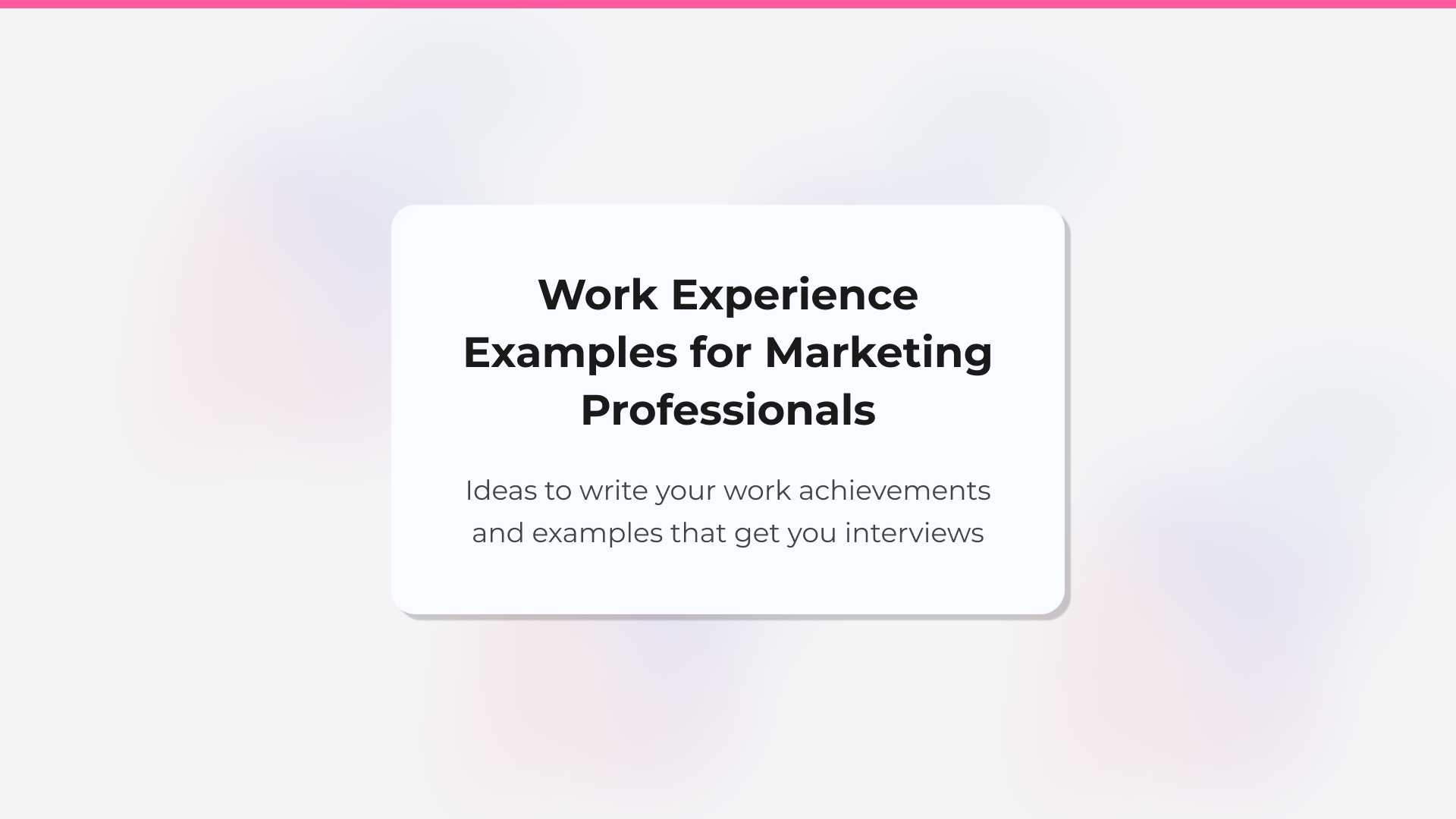
Examples of how to describe your work experience in a Digital Marketing resume
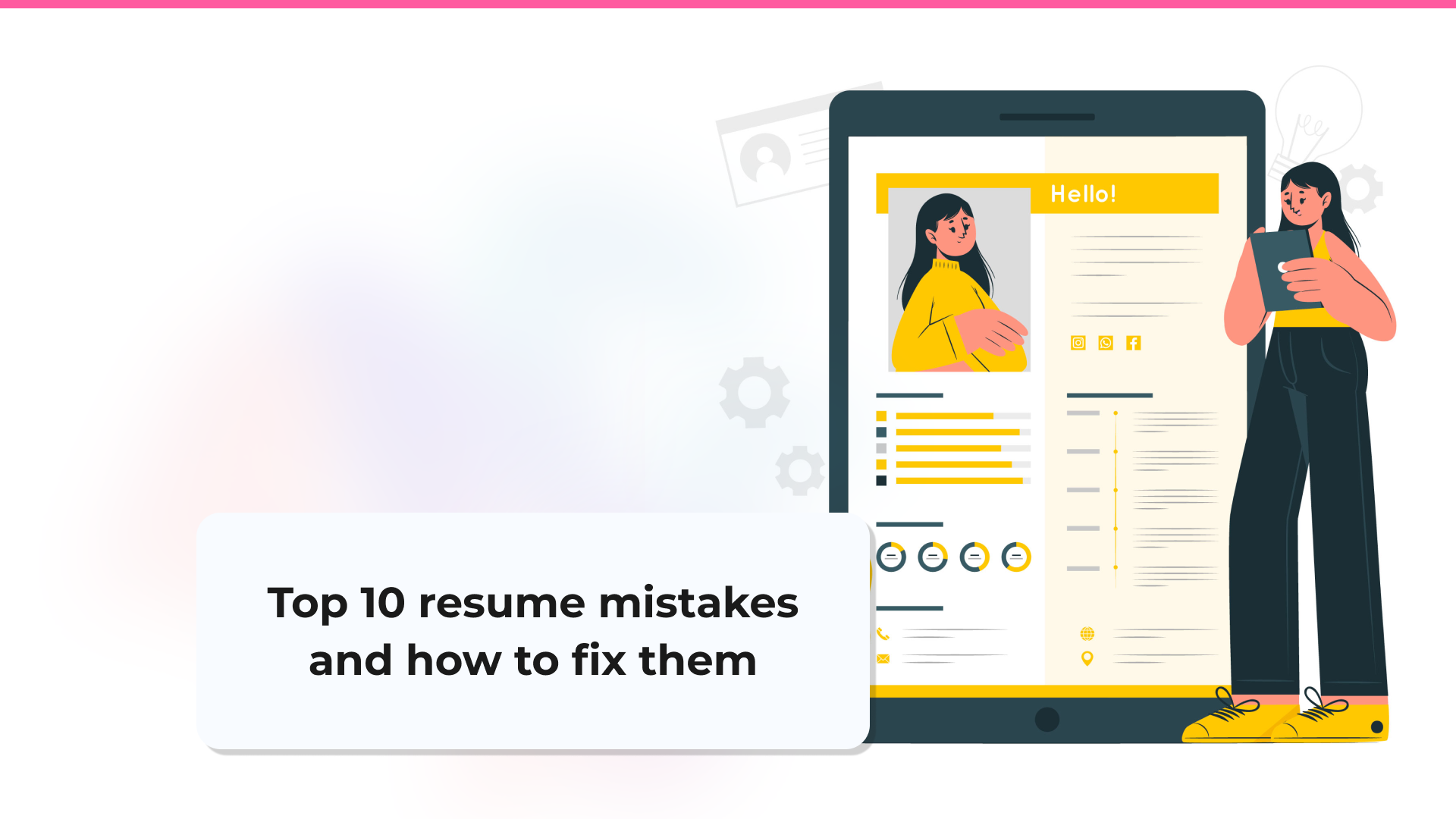
Top 10 resume mistakes to avoid in 2025 and how to fix them
